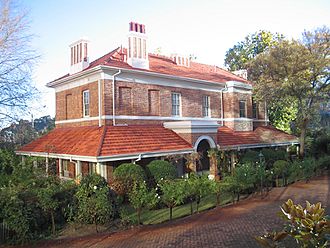Bishop's House, Perth facts for kids
Quick facts for kids Bishop's House |
|
|---|---|

Bishop's House, Perth
|
|
| General information | |
| Type | Heritage-listed building |
| Location | Perth, Western Australia |
| Coordinates | 31°57′15″S 115°51′05″E / 31.954192°S 115.851390°E |
| Type | State Registered Place |
| Designated | 5 January 2001 |
| Reference no. | 2093 |
Bishop's House is a very old and important building in Perth, Western Australia. It used to be the home of the main Anglican Church leader, called the Bishop, in Western Australia. You can find it at 78 Mounts Bay Road.
The Story of Bishop's House
Building a Home for the Bishop
Bishop's House is a two-story building that looks like a classic old house. It was built in 1859 for Mathew Blagden Hale. He was the very first Anglican Bishop of Western Australia. The house is on a special piece of land known as the Bishop's Land. This land is located in the western part of Perth's city center.
In 1856, Bishop Hale bought five plots of land on St Georges Terrace. He was a wealthy church leader and wanted to build a home for his family. He liked this spot because it had large grounds and a natural spring. There was also an existing house and stables on the land. Workers, who had special permits to work, helped build his new home.
Construction and Early Life
Bishop Hale and his family traveled to England in December 1858. While they were away, Bishop's House was completed in 1859. Bishop Hale paid for it himself, and it cost a lot of money back then. The old house on the property became the kitchen, and the stables were used for laundry and other tasks.
When the Hales returned in April 1860, their new home was ready. Bishop Hale planted beautiful trees in the front garden. He also created a fruit garden at the back of the property. He even had a garden wall built to enclose the rear of the land.
Other Buildings on the Bishop's Land
In 1860, Bishop Hale built a small cottage next to Bishop's House. It cost £360 and was called Clergy House or Bishop's Cottage. This cottage was used to house visiting church leaders from the countryside.
Later, in 1872, Bishop Hale built another house on the land. This two-story building was called Hale House. It was used to house and educate Aboriginal children. In 1875, Bishop Hale gave all his Perth properties to the Church's trust. He then left Western Australia to become the Bishop of Brisbane.
New Bishops and Changes
After Bishop Hale left, Henry Hutton Parry became the next Bishop in 1876. He lived in Bishop's House for a while. However, he found it too expensive to maintain such a large home. So, he moved his family into Bishop's Cottage instead. Judge Hensman then rented Bishop's House. Bishop Parry passed away in 1893.
The next Bishop to live in Bishop's House was Charles Owen Leaver Riley. He arrived in 1895, and the house was renovated for him. In 1904, Bishop Riley made Bishop's House even bigger. He used money that was raised from people in the Church. After he passed away in 1929, Henry Frewen Le Fanu became the next Bishop. Bishop's House was renovated again for him in 1930.
New Uses for the Historic House
After Bishop Le Fanu passed away in 1946, later Bishops decided not to live in Bishop's House. In 1959, a group called Legacy Australia rented it. Legacy Australia helps families of veterans, and Bishop's House became their Perth office. It was then known as Legacy House.
In 1974, Bishop's House was used by Anglicare. This group provides health and welfare services. They stayed there until they moved to a new location in West Perth.
In 1982, the Church's trust rented the site to a company. An English businessman, Lord Alistair McAlpine, used Bishop's House as his home and office. As part of the rental agreement, Bishop's House and its gardens were beautifully restored in 1984.
Bishop's House Today
Modern Developments Around the House
In 1999, two companies, Multiplex Property Trust and Hawaiian Property Group, bought the historic Bishop's House and its land. They then built two modern office towers next to Bishop's House. One tower has nine stories, and the other has twenty-seven stories.
A Restaurant in a Historic Setting
In November 2010, Bishop's House was turned into a special restaurant. It has several floors and is run by a famous chef named Kate Lamont. It's now called Lamont's Bishop's House.
Why Bishop's House is Important
Bishop's House is a very important historical building. The National Trust (WA) recognized its value in 1998. It was also added to the City of Perth's list of important places in 2001. On January 5, 2001, it was officially protected as a heritage site. This means it's on the State Register of Heritage Places.

